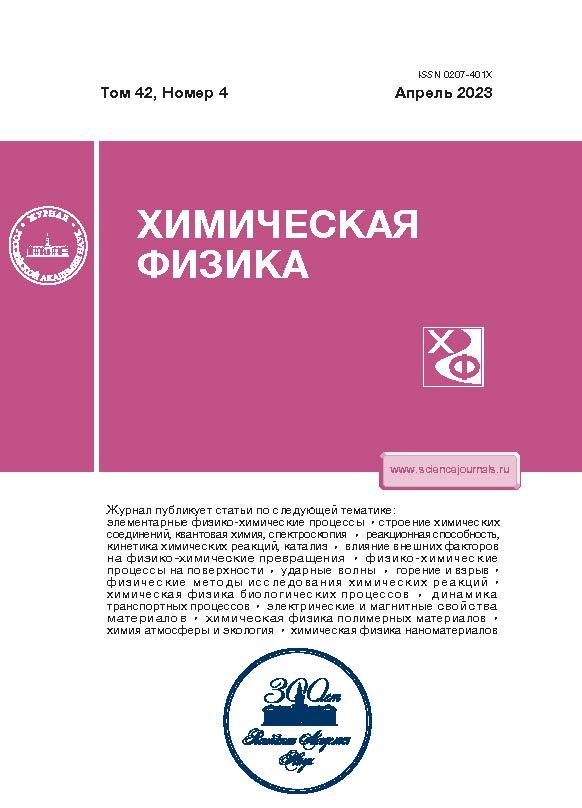Molecular Modeling of the Interaction of a Cluster of Chromium-Containing Polyacrylonitrile with Pollutant Gases
- Authors: Avilova M.M.1, Zolotareva N.V.2, Popova O.V.1
-
Affiliations:
- Don State Technical University
- Astrakhan State University
- Issue: Vol 42, No 4 (2023)
- Pages: 12-19
- Section: СТРОЕНИЕ ХИМИЧЕСКИХ СОЕДИНЕНИЙ, КВАНТОВАЯ ХИМИЯ, СПЕКТРОСКОПИЯ
- URL: https://rjmseer.com/0207-401X/article/view/674875
- DOI: https://doi.org/10.31857/S0207401X23040027
- EDN: https://elibrary.ru/MUUHYE
- ID: 674875
Cite item
Abstract
The possibility of the adsorption of priority pollutant gases (nitrogen dioxide, methane, ammonia, sulfur oxide (II), hydrogen sulfide, ozone, carbon monoxide, carbon monoxide (II), chlorine) on the surface of chromium-containing pyrolyzed polyacrylonitrile (pPAN) is evaluated. A model of a cluster of chromium-containing pPAN (Cr-PAN) is constructed. The thermodynamic parameters of the following systems are determined by the method of molecular modeling and compared: Cr-pPAN cluster–gas molecule, Cr-pPAN cluster–oxygen molecule, Cr-pPAN cluster–water molecule, Cr-PAN cluster–oxygen molecule–gas molecule, and Cr–pPAN cluster–water molecule–gas molecule. The effect of a water molecule on the process of adsorption of pollutant gases on the surface of a Cr–PAN cluster and the absence of an effect of an oxygen molecule located in the immediate vicinity of the clusters are revealed. It is established that Cr-pPAN has the property of selective adsorption of the following gases: nitrogen dioxide, chlorine, and ammonia. Within the density functional theory (DFT), the force parameters of the Cr–pPAN structure are estimated and the increase in the contact surface zone upon the introduction of a Cr2O3 molecule is confirmed.
About the authors
M. M. Avilova
Don State Technical University
Email: olvp2808@rambler.ru
Rostov-on-Don, Russia
N. V. Zolotareva
Astrakhan State University
Email: olvp2808@rambler.ru
Astrakhan, Russia
O. V. Popova
Don State Technical University
Author for correspondence.
Email: olvp2808@rambler.ru
Rostov-on-Don, Russia
References
- Ke F., Zhang Q., Ji L. et al. // Compos. Commun. 2021. V. 27. 100817; https://doi.org/10.1016/j.coco.2021.100817
- Герасимов Г.Н., Громов В.Ф., Иким М.И., Трахтенберг Л.И. // Хим. физика. 2021. V. 40. № 11. P. 65; https://doi.org/10.31857/S0207401X21110030
- Боднева В.Л., Кожушнер М.А., Посвянский В.С., Трахтенберг Л.И. // Хим. физика. 2019. V. 38. № 1. P. 75; https://doi.org/10.1134/S0207401X19010060
- Wang W., Zheng Y., Jin X. et al. // Nano Energy. 2019. V. 56. P. 588; https://doi.org/10.1016/j.nanoen.2018.11.082
- Efimov M.N., Sosenkin V.E., Volfkovich Yu.M. et al. // Electrochem. Commun. 2018. V. 96. P. 98; https://doi.org/10.1016/j.elecom.2018.10.016
- Imanian Z., Hormozi F., Torab-Mostaedi M., Asadollahzadeh M. // Sep. Purif. Technol. 2022. V. 289. 120749; https://doi.org/10.1016/j.seppur.2022.120749
- Kozlov V.V., Karpacheva G.P., Petrov V.S., Lazovskaya E.V. // Polym. Sci., Ser. A. 2001. V. 43. P. 20.
- Laffont L., Monthioux M., Serin V. et al. // Carbon. 2004. V. 42. P. 2485; https://doi.org/10.1016/j.carbon.2004.04.043
- Yoshida H., Sato N. // Rus. J. Phys. Chem. A. 2006. V. 110. P. 4232; https://doi.org/10.1021/jp0546397
- Kozlov V.V., Kozhitov L.V., Kostishyn V.G. et al. // IOP Conf. Ser: Mater. Sci. Eng. 2009. V. 5. 012021; https://doi.org/10.1088/1757-899X/5/1/012021
- Merdrignac-Conanec O., Bernicot Y., Guyader J. // Sens. Actuators, B. 2000. V. 63. P. 86; https://doi.org/10.1016/S0925-4005(00)00302-6
- Ghorpade R.V., Cho D.W., Hong S.C. // Carbon. 2017. V. 121. P. 502; https://doi.org/10.1016/j.carbon.2017.06.015
- Kim Ye-Na, Park Eun-Young, Lee Deuk Yong // J. Korean Ceram. Soc. 2007. V. 44. P. 194; https://doi.org/10.4191/kcers.2007.44.4.194
- Ерёмин В.С., Бронштейн Л.М., Дьячкова В.П. и др. // Высокомолекуляр. соединения. А. 1993. Т. 35. № 4. С. 450.
- Солодовников С.П., Бронштейн Л.М., Логинова Т.П. и др. // Высокомолекуляр. соединения. Б. 1993. Т. 35. № 1. С. 26.
- Авилова М.М., Марьева Е.А., Попова О.В., Финоченко Т.А. // ЖФХ. 2020. Т. 94. № 6. С. 898; https://doi.org/10.31857/S0044453720060047
- Авилова М.М., Марьева Е.А., Попова О.В., Иванова Т.Г. // Изв. вузов. Химия и химическая технология. 2020. Т. 63. № 4. С. 49; https://doi.org/10.6060/ivkkt.20206304.6008
- Авилова М.М., Петров В.В. // Хим. физика. 2018. Т. 37. № 4. С. 69; https://doi.org/10.7868/S0207401X18040088
- Авилова М.М., Петров В.В. // Хим. физика. 2017. Т. 36. № 7. С. 90; https://doi.org/10.7868/S0207401X17070020
- Avilova M.M., Petrov V.V. // Chemosensors. 2018. V. 6. № 3. P. 39; https://doi.org/10.3390/chemosensors6030039
- Gupta A.K., Paliwal D.K., Bajaj P. // J. Appl. Polym. Sci. 1995. V. 58. № 7. P. 1161; https://doi.org/10.1002/app.1995.070580710
- Surianarayanan M., Vijayaraghavan R., Raghavan K.V. // J. Polym. Sci., Part A: Polym. Chem. 1998. V. 36. № 14. P. 2503; https://doi.org/10.1002/(SICI)1099-0518(199810)36: 14<2503::AID-POLA9>3.0.CO;2-T
- Allinger N.L. // J. Amer. Chem. Soc. 1977. V. 99. № 2). P. 8127; https://doi.org/10.1021/ja00467a001
- Stewart J.J.P. // J. Mol. Modeling. 2013. V. 19. № 1. P. 1; https://doi.org/10.1007/s00894-012-1667-x
- Klamt A., Schuurmann G. // J. Chem. Soc., Perkin Trans. 2. 1993. № 5. P. 799; https://doi.org/10.1039/P29930000799
- Pritchard B.P., Altarawy D., Didier B. et al. // J. Chem. Inf. Model. 2019. V. 59. № 11. P. 4814; https://doi.org/10.1021/acs.jcim.9b00725
- Anandan K., Rajendran V. // Mater. Lett. 2015. V. 146. P. 99; https://doi.org/10.1016/j.matlet.2015.02.014
- Baker J. // J. Comp. Chem. 1986. V. 7. № 4. P. 385; https://doi.org/10.1002/jcc.540070402
- Пономарев Д.А. Дис. … канд. физ.-мат. наук. Екатеринбург: Институт физики металлов им. М.Н. Михеева УрО РАН, 2018.
- MOPAC2016 / James J.P. Stewart, Stewart Computational Chemistry/ Colorado Springs, CO, USA, 2016; http://openmopac.net/
- Ito S., Fedorov D.G., Okamoto Y., Irle S. // Comput. Phys. Commun. 2018. V. 228. P. 152; https://doi.org/10.1016/j.cpc.2018.01.014
- Abdullah M.M., Rajab F.M., Al-Abbas S.M. // AIP Advances. 2014. V. 4. 027121; https://doi.org/10.1063/1.4867012
- Skjelbred K.M., Astrand Per-Olof et al. // AIP Conference Proceedings. 2015. V. 1702. 090061; https://doi.org/10.1063/1.4938869
Supplementary files
















